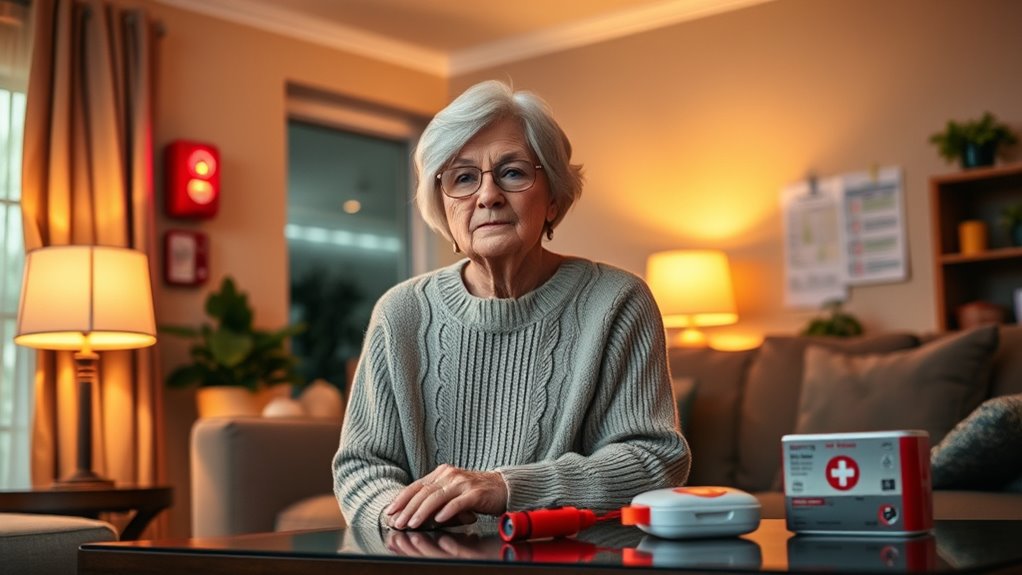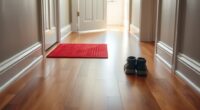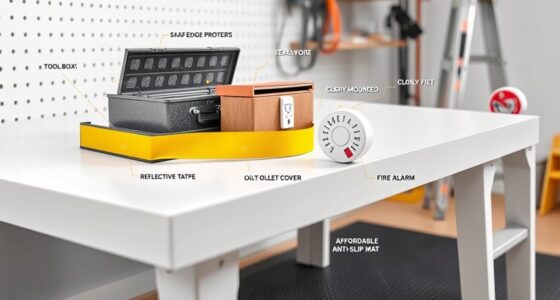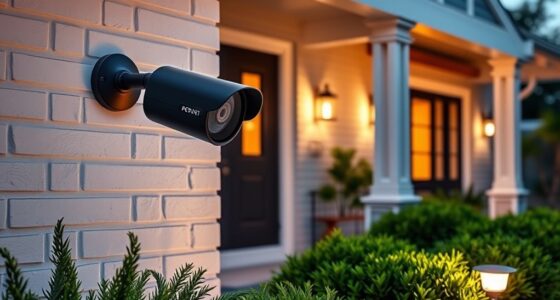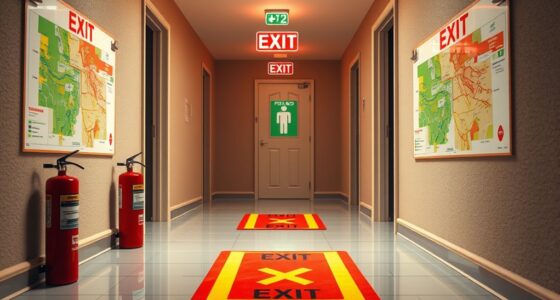To enhance fire safety for older adults, you should assess your home for hazards, create and practice a personalized escape plan, and keep fire safety devices like smoke alarms and extinguishers well-maintained. Design clear, accessible escape routes and rehearse fire drills regularly with everyone involved. Stay updated on safety measures and involve caregivers for additional support. Continue exploring more tips to ensure you’re prepared for any emergency and to bolster your safety plan.
Key Takeaways
- Develop and map out clear escape routes, including windows and doors, tailored to the home layout.
- Regularly practice fire drills with all household members to build confidence and identify improvements.
- Ensure smoke alarms are installed, tested monthly, and batteries replaced annually for reliable alerts.
- Keep pathways and exits unobstructed, well-lit, and clearly signage-marked for quick evacuation.
- Connect with local fire safety programs and community resources for ongoing education and safety support.
Assessing Fire Risks in the Home
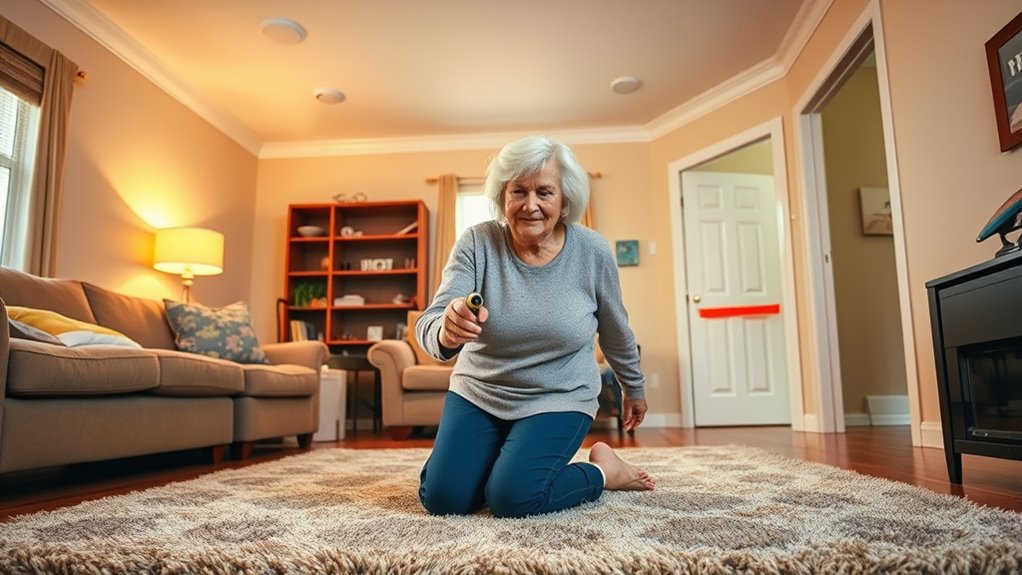
Have you ever considered how safe your home really is from fire hazards? To assess your risks, start by checking your fire extinguisher placement. Make sure extinguishers are easily accessible in key areas like the kitchen and garage. Proper placement guarantees quick response during an emergency. Next, focus on smoke alarm maintenance. Test alarms monthly, replace batteries annually, and ensure they’re installed on every level of your home, especially near bedrooms. Remove dust and debris from detectors to keep them functioning properly. Look around your living space for potential fire hazards, such as overloaded outlets or clutter near heat sources. Regularly inspecting these elements helps you identify vulnerabilities and keeps you prepared to act swiftly if a fire breaks out. Additionally, exploring fire safety education resources can provide valuable tips tailored specifically for older adults.
Creating a Personalized Escape Plan

Creating a personalized escape plan starts with mapping out your home so you know every exit route. Make sure to practice your plan regularly, so it becomes second nature. This preparation helps you stay calm and confident during an emergency.
Map Your Home
How can you guarantee you escape quickly and safely if a fire breaks out? Start by mapping your home. Identify all exits, including windows and doors, and mark safe routes on a floor plan. Make sure your fire alarm and smoke detector are positioned to alert you early. Practice your escape routes regularly, and update your map if you rearrange furniture or add new rooms. Use the table below to help you plan your escape:
| Room | Exit Options | Special Notes |
|---|---|---|
| Living Room | Front door, window | Keep pathways clear |
| Kitchen | Back door, window | Turn off stove if possible |
| Bedroom | Balcony, door | Keep accessible nightstand |
| Bathroom | Window, door | Have a ladder nearby |
Having a clear map ensures quick, safe escape during emergencies. Additionally, familiarizing yourself with home safety features can significantly improve your response time during a fire.
Practice Regularly
Practicing your escape plan regularly is essential to make sure you’re prepared if a fire occurs. A safety rehearsal or fire drill helps you identify potential issues and build confidence. To make your practice effective, consider these steps:
- Schedule a fire drill at least twice a year, involving everyone in your household.
- Use your personalized escape plan during each drill, practicing different routes if needed.
- Test your smoke alarms beforehand to ensure they’re working properly.
- After each safety rehearsal, review what went well and identify areas for improvement.
- Incorporate fire safety education into your routine to stay informed about best practices and updates.
Regular practice helps you respond calmly and quickly during an actual fire. Keep your escape plan fresh in your mind, and adjust it as needed to stay prepared.
Choosing and Installing Fire Safety Devices

Choosing the right fire safety devices is vital to protect yourself and your home. Proper selection and installation guarantee quick detection and response during emergencies. Start with reliable smoke alarms, which require regular fire alarm maintenance to stay effective. Consider installing a sprinkler system to control fires early. When selecting devices, look for easy-to-use features suited for your needs. Proper placement is essential—install alarms on every level and outside sleeping areas. Additionally, understanding Fokos can help you stay informed about safety updates and best practices.
Designing Clear and Accessible Escape Routes

To guarantee you can escape quickly during a fire, designing clear and accessible escape routes is essential. First, ensure pathways are free of clutter and wide enough for easy passage. Second, use visible visual signage to clearly mark exits and escape routes, making them easy to identify even in smoke or low visibility. Third, prioritize lighting accessibility by installing bright, reliable lights along corridors and stairs, especially in darker areas. Fourth, keep lighting and signage unobstructed and well-maintained to ensure continuous visibility. These measures help create a safe environment, allowing you to navigate quickly and confidently. Properly designed escape routes reduce confusion and delays, increasing your safety during emergencies. Incorporating outdoor kitchen principles such as good layout and clear pathways can also enhance overall safety and functionality.
Practicing Fire Drills Regularly

Regular fire drills are essential for ensuring you know how to respond quickly and safely in an emergency. Consistent practice helps reinforce your escape plan and reduces panic. To stay prepared, establish a fire drill scheduling routine—monthly or quarterly works best. During drills, focus on practicing emergency communication, so you know how to alert others and call for help efficiently. Use the table below to plan your drills:
| Month | Focus Area | Notes |
|---|---|---|
| January | Evacuation routes | Practice with mobility aids |
| April | Emergency communication | Test phone and alarm systems |
| July | Nighttime procedures | Practice in darkness |
| October | Multiple exits | Use different routes |
| December | Family involvement | Review and update plan |
Regular practice guarantees you’re confident and prepared. Additionally, understanding fire safety equipment such as smoke detectors and fire extinguishers can enhance your safety during emergencies.
Involving Family and Caregivers in Safety Planning

Involving family and caregivers in safety planning is essential because they can provide support, assistance, and reassurance during emergencies. Your family involvement guarantees everyone knows their role, making responses quicker and more effective. Effective caregiver coordination is key to a smooth safety plan. Consider these steps:
- Share your fire safety plan with all family members and caregivers.
- Assign specific responsibilities, like helping with evacuation or checking smoke alarms.
- Schedule regular safety reviews and practice drills together.
- Keep emergency contact information updated and accessible for everyone.
- Incorporate eye patch benefits into your routine if eye health concerns impact mobility or alertness, ensuring clear communication during emergencies.
This collaboration builds confidence and ensures that everyone, especially you, feels prepared. Strong family involvement and caregiver coordination create a safety net, reducing risks and easing anxieties during an actual fire.
Maintaining and Updating Safety Measures

You should regularly assess your home for fire hazards and guarantee safety measures stay effective. Make it a habit to update your emergency equipment, like smoke detectors and fire extinguishers, as needed. Staying proactive helps keep your environment safe and ready for any emergency. Incorporating security lighting can further deter criminal activity and improve overall safety.
Regular Safety Assessments
How often do you review and update your safety measures to keep your home secure? Regular safety assessments are crucial for maintaining effective fire safety. Start by evaluating your current fire safety education efforts to ensure everyone understands fire hazards and escape plans. Next, involve community outreach by connecting with local programs that offer resources or training. Then, 1) check smoke detectors and fire extinguishers monthly, 2) review and practice your fire escape plan quarterly, 3) update any safety equipment or alarms as needed, and 4) stay informed about local fire safety regulations. Incorporating self watering plant pots as part of your home safety setup can help prevent water damage and related hazards. These assessments help identify vulnerabilities and keep safety measures current. Consistent reviews ensure you’re prepared, and engaging with fire safety education and community outreach strengthens your overall safety efforts.
Updating Emergency Equipment
Regularly updating your emergency equipment is essential to guarantee your fire safety measures remain effective. Confirm your fire alarm maintenance is up to date; test alarms monthly and replace batteries at least once a year. Check that smoke detectors are functioning properly and replace units every ten years. Keep your emergency kit updated with fresh batteries, medical supplies, and any necessary medications. Review your kit regularly to replace expired items and add new essentials. Clear escape routes of obstacles and confirm all equipment is in good working order. Staying proactive by maintaining and updating your safety equipment helps you respond quickly during an emergency, reducing risks and increasing your safety during a fire. Regularly inspecting fire purifier filters and replacing them as needed ensures optimal air quality and safety. Consistent checks ensure your safety measures are reliable when you need them most.
Resources and Support for Fire Safety Preparedness

Ensuring fire safety for older adults often involves accessing a variety of community resources and support systems. These fire safety resources can help you develop effective plans and stay prepared. Community support plays a crucial role in this process. Here are four key ways to utilize resources:
- Contact local fire departments for free safety assessments and advice.
- Access senior centers that offer fire safety education tailored for older adults.
- Join neighborhood watch or community groups focused on safety and emergency preparedness.
- Use online platforms and hotlines for information on fire safety equipment and support programs.
Frequently Asked Questions
How Often Should Fire Safety Plans Be Reviewed and Updated?
You should review and update your fire safety plan at least once a year to make certain it remains effective. Incorporate regular fire drills, ideally every six months, to practice your escape routes and identify any issues. Stick to a consistent plan review schedule, like annually, and update it whenever there are changes in your environment or health. Regular reviews and drills keep you prepared and confident in an emergency.
What Are the Best Types of Fire Alarms for Older Adults?
You might think loud, traditional alarms are enough, but for older adults, wireless detectors and voice alerts are the best choices. Ironically, the most high-tech alarms are often the simplest to depend on—voice alerts clearly tell you what’s wrong, and wireless detectors ensure coverage even in hard-to-reach areas. These features help prevent confusion and ensure quick action, making fire safety more effective and less stressful.
How Can I Ensure My Home Is Fully Accessible During a Fire?
You can guarantee your home is fully accessible during a fire by making key home modifications, like installing ramps and wide doorways, to facilitate easy movement. Keep emergency exits clear of clutter and ensure doors and windows open easily. Practice fire drills regularly to familiarize yourself with escape routes. Also, install visual and auditory alarms, and consider adding safety features like grab bars near exits for added support during emergencies.
What Community Resources Are Available for Fire Safety Education?
Did you know community outreach programs often host educational workshops on fire safety? These resources are designed to help you understand fire prevention, escape plans, and safety measures. Local fire departments, senior centers, and community organizations frequently offer free or low-cost classes. Check their schedules or visit their websites to find workshops near you. Participating in these programs empowers you with knowledge and confidence to stay safe during emergencies.
How Do I Involve Neighbors in Fire Safety Planning?
You can involve neighbors in fire safety planning by engaging them directly through neighbor engagement activities. Start by organizing a safety communication plan, where you share fire safety tips and emergency procedures. Encourage everyone to check on each other regularly, especially vulnerable neighbors. Building a strong community network guarantees everyone stays informed and prepared, making your neighborhood safer and more resilient in case of a fire emergency.
Conclusion
By taking these steps, you’ll build a safety net as sturdy as a fortress around your home. Regularly update your plans, involve loved ones, and stay vigilant—you’re the captain steering your safety ship through any storm. Fire safety isn’t a one-time task; it’s an ongoing journey. With a little effort, you’ll create a safe haven where you can breathe easy, knowing you’re prepared to face any emergency head-on.
